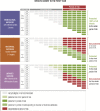Epidemiology and prevention of respiratory syncytial virus infections in children in Italy
- PMID: 34600591
- PMCID: PMC8487331
- DOI: 10.1186/s13052-021-01148-8
Epidemiology and prevention of respiratory syncytial virus infections in children in Italy
Abstract
Respiratory syncytial virus (RSV) is the leading global cause of respiratory infections in infants and the second most frequent cause of death during the first year of life. This highly contagious seasonal virus is responsible for approximately 3 million hospitalizations and 120,000 deaths annually among children under the age of 5 years. Bronchiolitis is the most common severe manifestation; however, RSV infections are associated with an increased long-term risk for recurring wheezing and the development of asthma. There is an unmet need for new agents and a universal strategy to prevent RSV infections starting at the time of birth. RSV is active between November and April in Italy, and prevention strategies must ensure that all neonates and infants under 1 year of age are protected during the endemic season, regardless of gestational age at birth and timing of birth relative to the epidemic season. Approaches under development include maternal vaccines to protect neonates during their first months, monoclonal antibodies to provide immediate protection lasting up to 5 months, and pediatric vaccines for longer-lasting protection. Meanwhile, improvements are needed in infection surveillance and reporting to improve case identification and better characterize seasonal trends in infections along the Italian peninsula. Rapid diagnostic tests and confirmatory laboratory testing should be used for the differential diagnosis of respiratory pathogens in children. Stakeholders and policymakers must develop access pathways once new agents are available to reduce the burden of infections and hospitalizations.
Keywords: LRTI; Monoclonal antibodies; RSV; RSV epidemiology; RSV pediatric burden; RSV prevention; RSV vaccines; Respiratory syncytial virus.
© 2021. The Author(s).
Conflict of interest statement
All authors have been participants at advisory boards and/or have been speakers at symposia and/or lecture sponsored by Sanofi and/or AbbVie. G Checcucci Lisi and S Parisi are employees of Sanofi Pasteur, working at the Medical Affairs Department, and may hold shares/stock options as part of remuneration package.
Figures





References
-
- Barbati F, Moriondo M, Pisano L, Calistri E, Lodi L, Ricci S, Giovannini M, Canessa C, Indolfi G, Azzari C. Epidemiology of respiratory syncytial virus-related hospitalization over a 5-year period in Italy: evaluation of seasonality and age distribution before vaccine introduction. Vaccines (Basel) 2020;8(1):15. doi: 10.3390/vaccines8010015. - DOI - PMC - PubMed
-
- Public Health England . Respiratory syncytial virus (RSV): symptoms, transmission, prevention, treatment. 2008.
-
- Centers for Disease Control and Prevention . RSV in infants and young children. 2020.
-
- Cutrera R, Wolfler A, Picone S, Rossi GA, Gualberti G, Merolla R, del Vecchio A, Villani A, Midulla F, Dotta A. Impact of the 2014 American Academy of Pediatrics recommendation and of the resulting limited financial coverage by the Italian Medicines Agency for palivizumab prophylaxis on the RSV-associated hospitalizations in preterm infants during the 2016-2017 epidemic season: a systematic review of seven Italian reports. Ital J Pediatr. 2019;45(1):139. doi: 10.1186/s13052-019-0736-5. - DOI - PMC - PubMed

